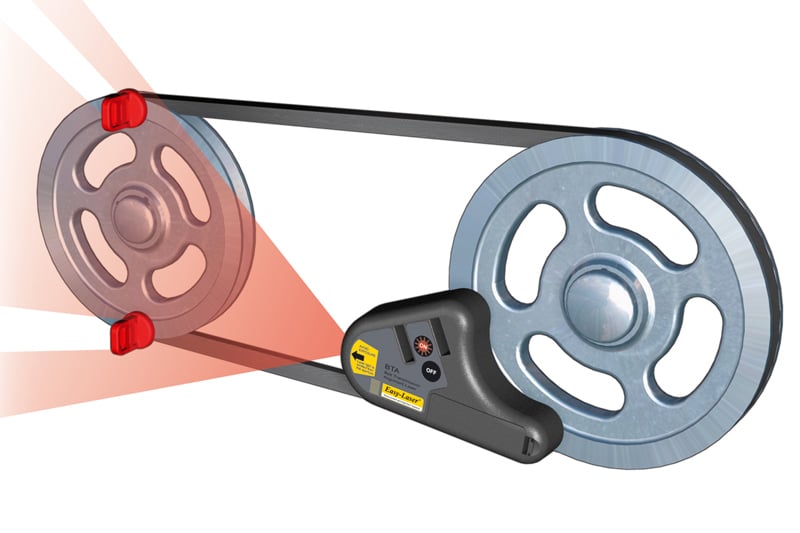10 Reasons For Using Laser Alignment On Your Machinery

Machinery breakdowns, production losses and inferior product quality are just some of the severe consequences of shaft misalignment, but there are proven solutions to prevent these from happening.
However, the rapid evolution of laser alignment technology has revolutionised the process, enabling shaft alignment to be done up to 10 times faster than with dial gauges or straight edge methods and with pinpoint accuracy.

Easy-Laser D90 BTA is the perfect tool for sheave and pulley alignment. Mounted in a few seconds, the laser line projected onto the targets allows you to quickly ascertain and correct the misalignment.
If your operation utilises any type of rotating machinery, you will be interested in the following 10 reasons for using laser alignment equipment.
- Avoid costly downtime and production losses
For equipment to run smoothly and efficiently, it requires regular maintenance, lubrication, upkeep and the correct alignment. When this doesn’t happen and when shafts or belts are misaligned, the equipment can breakdown unexpectedly, resulting in costly downtime, disrupted production schedules and consequent losses. Ongoing assessment using an accurate and reliable laser alignment tool can prevent breakdowns and reduce the likelihood of unplanned downtime.
- Decrease energy consumption
Misaligned shafts can lead to increased friction and excessive wear, which in turn leads to excessive energy consumption. On the flip side, equipment that is correctly aligned with a laser tool and which is operating at peak performance will require less power.
- Avoid premature wear and tear
Seal and bearing failures are more likely in misaligned machines and will result in increased friction which can cause premature wear and tear. Replacing the seals won’t solve the problem of future seal failure – the only way to do it is to correct the original misalignment, which is best done with a laser tool. When machinery is misaligned, it can also result in increased noise and vibration. A reliable, precise and flexible laser alignment tool will enable manufacturers to correct even the tiniest error which can lead to noise and vibration issues.
- Generate reports immediately
High-resolution laser systems can generate PDF reports directly from the instrument enabling fast and easy interpretation of results. The documentation can also be saved for future use.
- Improved speed, precision and repeatability
Misalignment can lead to inaccuracies in the set up of equipment which can compromise the items being machined. Laser alignment is faster and more accurate than old technology such as dial gauges and straight edge methods, where the low resolution can lead to reading errors and dial hands sticking. Lasers work on high-resolution non-contact technology which enables them to measure down to 0.001mm, giving manufacturers the confidence that their products will be error-free and will meet specifications, time after time.
- Decreased maintenance or replacement costs
Incorrectly aligned shafts can result in increased maintenance costs and expensive replacement of parts and equipment such as seals, bearings, lubricants and coupling and foundation bolts. A laser alignment tool will enable companies to keep their equipment operating at optimum efficiency and at peak performance for longer, thereby keeping a lid on maintenance and replacement costs. Moreover, increased competition and tight profit margins are forcing manufacturers to look at more cost-effective preventative maintenance programmes – and laser alignment equipment supports their endeavours.
- No wasted materials
Correct calibration and alignment of machinery will reduce scrap rates. Laser alignment enables manufacturers to avoid unnecessary waste of materials due to re-runs as a result of tolerance errors or calibration inaccuracies.
- Easy to use
Today’s laser alignment equipment is quick to set up, much easier to use and much more reliable than traditional alignment technology. This means that operators can quickly learn how to manage the technology without requiring extensive prior experience or complicated calculations. What’s more, errors that are traditionally associated with old technologies such as bending of the hardware, substandard dial bar, bar sag and incorrect clamp set-up are eliminated when laser technology is used.
- Keep up with technology
The advent of new manufacturing materials and more flexible tooling requires more advanced, adaptable equipment – and laser alignment technology more than adequately meets these requirements. The expanded capabilities of a laser alignment system also enable operators to broaden the scale and scope of the alignments and measurements that they’re able to do, such as base flatness, twist and straightness.
- Measure small shaft rotation
Laser systems make it possible to measure shaft rotation as small as 40 degrees, plus they provide a true representation of what’s happening between the rotating axes of the shafts being measured. With old technology like dial gauges, the readings only provide data for one end of the shaft.
An ongoing alignment maintenance programme is vital in order to keep manufacturing and fabrication operations running smoothly – and a laser alignment tool from a reputable supplier such as Nexxis will prevent breakdowns, downtime and a range of other issues that can negatively impact a company’s bottom-line. For more information on these versatile, advanced yet user-friendly products, please call the experienced Nexxis team on 08 9418 4952.
